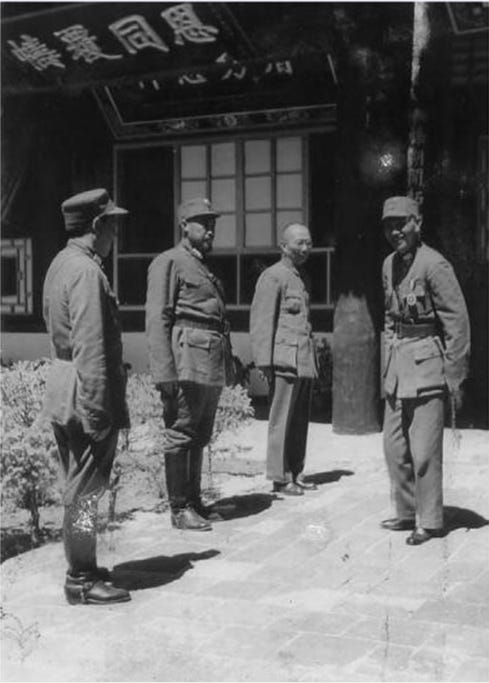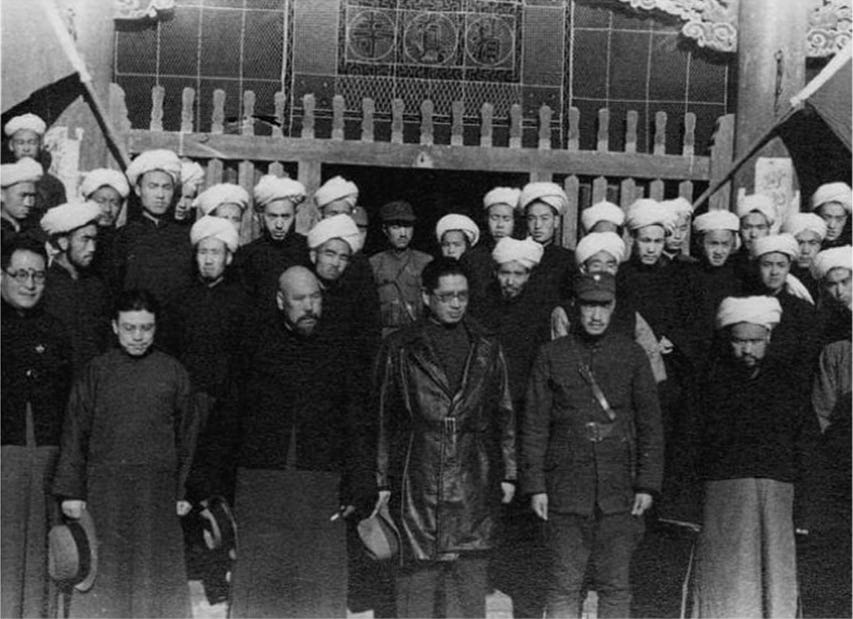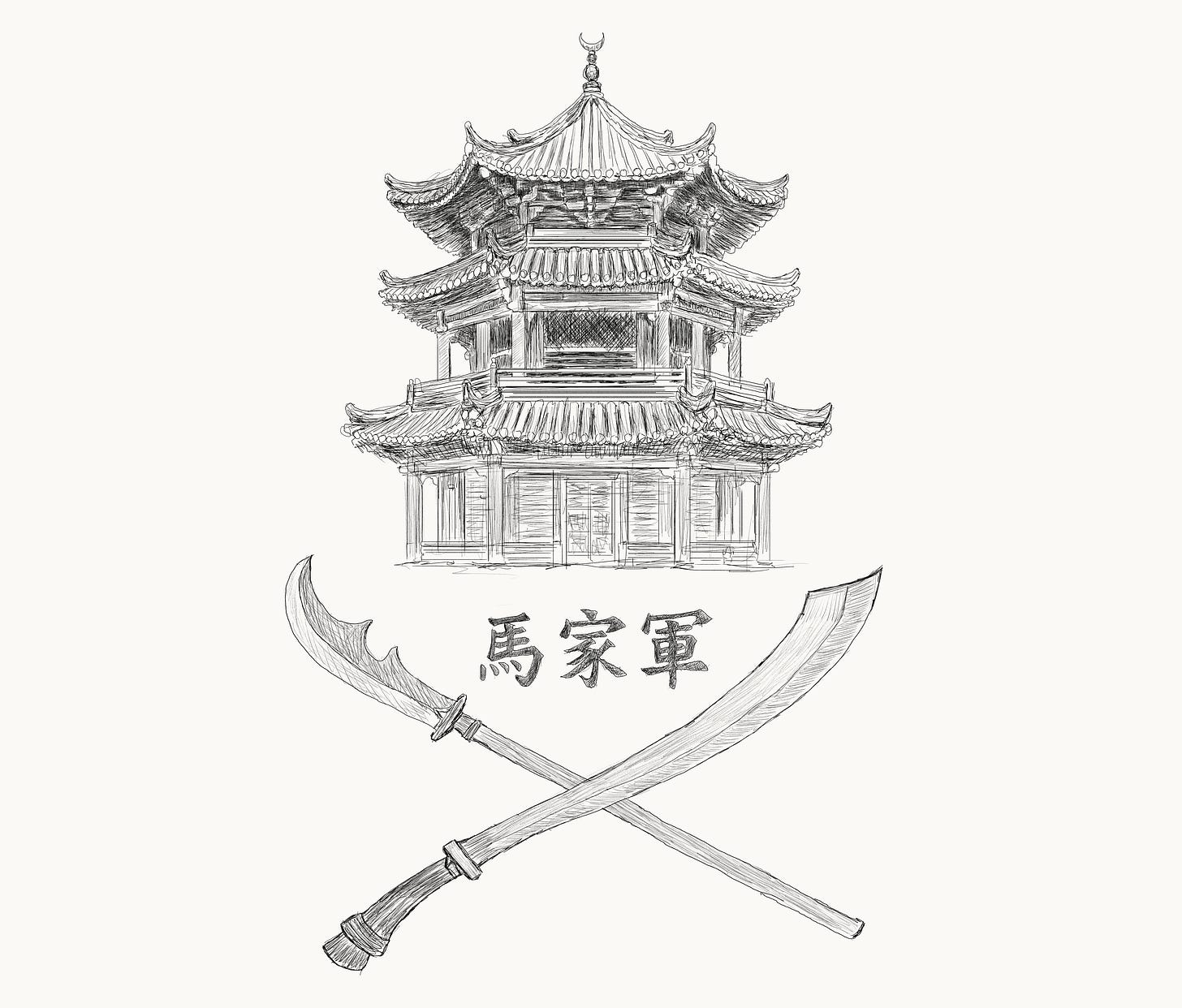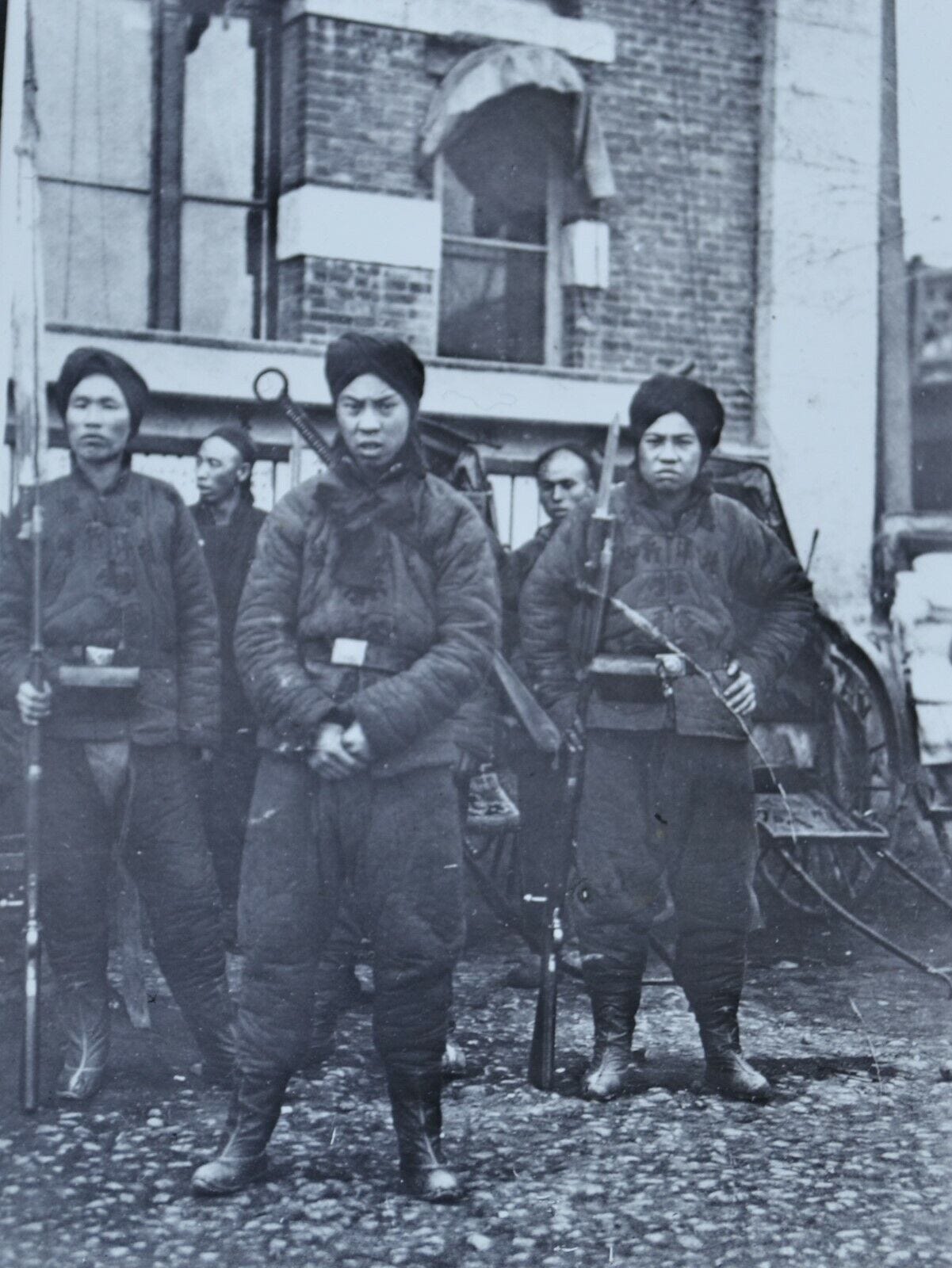The Ma Clique
How Hui warlords became autonomous powerbrokers in China.
In late 1911, over a dozen Chinese provinces declared revolutionary independence from the empire that ruled them for over 260 years: the Great Qing Dynasty. A two-year-old toddler sat on the throne. The empire was dying. Millennia of imperial rule was about to end.
Chaos followed as various forces fought for China’s future. Communists and nationalists, Han and non-Han, all struggled for local and national control. Amid the unrest, one particular clique in the northwest stood out for its consistent focus on local independence, family-based alliances, and a relatively cohesive religious identity.
The ‘Ma Clique’ was a loose alliance of Hui Muslim families based in the northwestern provinces of Gansu, Shaanxi, Qinghai, and Ningxia. Several major warlords bore the surname “Ma,” a common Hui name that scholars posit was adopted in honour of the prophet Muhammad ﷺ.
Politically, prominent Ma warlords chose to align with those who emerged victorious after decades of civil war and foreign invasion. Their complex history represents an agency that challenges both the simplistic framing and dichotomies that characterise Muslim engagement in politics, and today’s Chinese Communist Party (“CCP”) version of post-Qing Chinese history.
Rise of the Hui
Most chroniclers began documenting the Ma families by the mid-19th century, long after Islam had taken root in China – the first Muslims arrived during the early Tang Dynasty (618-907). Over time, incoming Muslims from Central Asia (and further West) intermarried with Han Chinese as they settled in the empire. The Hui Muslims — one of 55 recognised minority ethnicities in today’s People’s Republic of China — see themselves as the result of this prolonged presence and settlement. They are indigenous Chinese Muslims. The 2020 Chinese census lists 8.3 million Hui Muslims in China today.
By the 19th century, the Hui had established major population centres in the northwestern areas of Gansu, Ningxia, Qinghai, and Shaanxi; the Southwestern area of Yunnan; and the Central/Northern areas of Shandong and Henan. Today, Gansu is a province known for its difficult terrain, arid climate, and high poverty rates. In the Han Chinese imagination, travelling West always meant approaching a less friendly hinterland—the edge of civilisation. This was also true in the 19th century, when the Hui of Gansu, Qinghai, and Ningxia were seen as non-Han bandits galloping along a lawless frontier, preferring local autonomy, inter-family feuds, religious conflict, and, once in a while, full-on rebellion against the Qing.
A major rebellion emerged in the northwest in 1781, when a sectarian conflict broke out between rival subgroups of the influential Naqshbandi Sufi order: the Jahriyya and Khufiyya. The locals referred to these Sufi groups as menhuan, which were more than just religious factions; they were also important nodes within the regional military-commercial patchwork.
The rebellion first took off in the city of Hezhou, now known as Linxia City, the centre of Hui Muslim life and home to the burial sites of many Sufi saints in the region. Leaders among the Sufi sub-orders were known as jiaozhang, powerful figures with access to wealth, military forces, and political sway. Over time, the jiaozhang position was inherited within families like an heirloom, blurring the lines of religious legitimacy. The Ma warlords were entrenched in this system.
The imperial centre viewed the Jahriyya-Khufiyya violence as a major security threat, so they sent forces into Gansu to intervene. This triggered two Jahriyya revolts; both failed, but the violence marked the beginnings of militarisation and warlordism in the northwest. Sustained local rivalries over commerce and tribalism persisted into the late 1800s, as the Qing lost control due to internal rebellions and foreign encroachment. Losing a humiliating war (1895-96) to the Japanese finally led the imperial elite to embark on a desperate campaign of military modernisation.
But modernisation also introduced educated officers with subversive republican ideals into the ranks. Regional military leaders and their armies were already entrenched in their locales. Control of China was up for grabs. The Ma families maintained a grip on the northwest in service of national cohesion, regardless of which forces prevailed at any given moment.
The Ma Clique Genealogy
The Ma Clique included three major branches, each located in a different area of the Hui northwest. They were among the Hui elite of the region and were not the only Hui Muslims carrying the Ma surname.
The Ma Zhan’ao Family
Perhaps the most prominent name among all Ma warlords and leaders is Ma Zhan’ao (1830-86), born in Hezhou with no connection to the elite Sufi menhuan. Zhan’ao, like most Hui men, engaged in martial arts from a young age, partly as a means to protect against local bandits. The Qing state offered weak security and high taxes. Local ethnic conflicts between Hui and Han (and sometimes Tibetans, or fan) became common.
Gansu and neighbouring Shaanxi, both major Muslim centres at the time, also experienced food shortages, famine, and drought, further eroding security. The Qing tried to form local militias, known as tuanlian, to help, but many became undisciplined vigilante militias. Many bullied helpless civilians. By the 1860s, when Ma Zhan’ao was still a young man, the northwest was ripe for another rebellion.
In 1862, an ordinary argument over bamboo in a Shaanxi market may have sparked the massive Dungan Revolt (1862-77), a multiregional rebellion that saw the rise of all three major Ma families as militarist leaders. It involved Muslims of various ethnic backgrounds, including Turkic groups like the Salar and Uyghur, along with Mongolic groups like the Dongxiang and Bao’an.
The Hui of the Gansu-Ningxia-Shaanxi area made up the bulk of the revolt. In this mix, Ma Zhan’ao rose to become the most prominent anti-Qing general, commanding forces that landed major victories. Zhan’ao was also an imam (or ah hong) of the Khuffiya Naqshbandi suborder in Hezhou and is known for engaging in both effective warfare and adroit diplomacy with the Qing, depending on his goals. He is known for facilitating the escape of Han civilians from cities affected by war in Gansu. Not all Hui rebels were so conscientious.
Another major Hui rebel general was Ma Hualong (head shaykh of the Jahriyyah Naqshbandi order in the Hui northwest), who was seen by the Qing as the chief instigator of the rebellion and whose fighting in Shaanxi, along with that of other rebel leaders, helped put an end to the thriving Muslim life there. Furthermore, a hardline Hui general, Bai Yanhu, also led his own forces against the Qing approach.
The Qing responded by deploying the legendary general Zuo Zongtang to quell the Muslims. Zuo started with good success, famously executing Ma Hualong in 1871. Zuo then travelled further West, expecting to lay siege to Ma Zhan’ao’s stronghold in Hezhou. But Zuo failed against Zhan’ao’s savvy generals, who knew the local terrain.
Ma Zhan’ao could have pursued Zuo to solidify Hui separatism in Gansu and Shaanxi, but he did not. Instead, he made a decision that stands out in the annals of Hui history: Ma Zhan’ao ordered his son, Ma Anliang, to travel to the enemy’s field camp and offer Zuo and the Qing his immediate surrender of Hezhou. He offered to join the Qing forces to quell any lingering separatism in the area. General Zuo readily accepted Ma Zhan’ao into his forces and brought the broader rebellion to an end. This alignment with the Qing set the tone for many Hui figures’ later conformity with Chinese power and society for the next almost two centuries.

The Ma Qianliang and Ma Haiyan Families
Ma Zhan’ao’s command included two major Ma generals: Ma Qianling (1842-1910) and Ma Haiyan (1837-1900). They are the heads of the other two main branches of the Ma Clique warlords, though neither is the most famous figure in their respective lineages. Both followed Zhan’ao during the 1862 Dungan Rebellion by conforming to the Qing Empire’s wishes.
Two of Ma Qianling’s sons became prominent Hui warlords: Ma Fulu (1854–1900) and Ma Fuxiang (1876–1932). Ma Haiyan also had a prominent son, Ma Qi (1869–1931). All were contemporaries of Ma Zhan’ao’s son, Ma Anliang (1855–1918). Together, they formed the second generation of the Ma Clique.
All played a crucial role for the Qing in 1895, when yet another Dungan Rebellion (1895-96) broke out, this time involving belligerents from Gansu and Qinghai. The rebellion started in an Eastern region of Qinghai, then called Xunhua (now the Xunhua Salar Autonomous County), the stronghold of the Turkic Salar Muslims, another recognised Muslim minority group in China today. The 1895 rebellion also began with accusations of Jahriyya vs. Khuffiyah over “misleading the people,” sorcery, and other religious disputes.
Animosities then evolved into anti-Han animus, this time involving both Hui and Salar militias. General Ma Yonglin, a Jahriyya imam, led the rebellion and called for a broad uprising against the Qing in northwestern China. They met stiff resistance from all three major Ma Clique lineages, who followed Ma Zhan’ao’s example to defend Qing interests, eventually defeating Ma Yonglin in a brutal showdown. All eventually fought under another legendary Qing general, Dong Fuxiang (who fought under Zuo Zongtang).
All three major Ma families also followed Dong back to Beijing in 1898, where another mass conflict further hastened the Qing’s demise.
Joining the National Resistance
Thanks to extensive foreign encroachment, the presence of Christian missionaries became pervasive across China during the late Qing era. This bred anti-Christian and anti-foreign animus among locals, who often saw missionaries receive tax exemptions while they had to pay extra taxes thanks to lost wars and unfair treaties. Popular anger was rife.
Among the peasantry emerged a secret group called the Society of the Righteous and Harmonious Fists that preached an anti-Christian, anti-foreigner message while claiming to possess miraculous spiritual abilities, such as the ability to fend off bullets. Their followers—known as “Boxers”—began to attack Christian missionaries, other foreigners, and even some Qing officials across parts of Northern China. The Boxer Rebellion was in full swing by 1900.
Hundreds of thousands of participants fought their way towards Beijing, pillaging foreign sites along the way. Convinced of their invulnerability to bullets and other weapons, the Boxers laid siege to the International Legation Quarter in Beijing, where hundreds of foreign diplomats and family members—hailing from Britain, Germany, the United States, France, Russia, Japan, Italy, Austria-Hungary, and Belgium—sought safety and refuge along with hundreds of Chinese Christian converts.
The famous “Siege of the International Legations” lasted 55 days in the summer of 1900 and was supported by the Empress Dowager Cixi, who controlled the Qing court. She endorsed the Boxers’ mass campaign as a pro-Qing movement, declared war on all foreign parties in China, and aligned the empire’s own forces with the Boxers’ siege. These included the forces of General Dong and his Ma officers from Gansu. Dong’s soldiers both protected the Qing court and supported the siege with the Boxers. The Hui forces made their name during this infamous confrontation in Beijing, which drew the world’s attention. From this point on, Dong’s Hui fighters would be known as the “Gansu Braves.”
In August 1900, an alliance between the United Kingdom, Russia, France, Japan, the United States, Italy, Germany, and Austria-Hungary—the famous “Eight-Nation Alliance”—gathered to invade China and end the siege. They clashed with imperial forces and the Boxers. The Gansu Braves fought the invaders, and Ma Fulu died, becoming a symbol of Chinese resistance. Four of his cousins also perished. Ma Haiyan also didn’t make it home, and his son Ma Qi took over his unit. The Alliance eventually broke the siege and occupied Beijing.
The Empress Dowager then fled as occupying troops and foreign civilians engaged in mass looting of Qing palaces and other areas—a symbol of foreign humiliation. The looting was so infamous as to draw criticisms from Western observers like Mark Twain, whose essay “To the Person Sitting in Darkness” mocked how the looters destroyed only “what they cannot carry away.”
A year later, the Empress Dowager Cixi was allowed to return to Beijing only after agreeing to even more humiliating indemnity payments that totally bankrupted the Qing. The empire limped on uselessly for another decade. But the Ma fighters gained significant trust, favour, and reputation. Ma Fuxiang rose particularly fast due to royal Qing favour, even escorting the royals westward during the revolutionary violence of the 1910s. He held posts in the northwest and in Xinjiang. For years, he consolidated his military autonomy, built regional networks from his Ningxia base, established a pioneering matchstick factory, entrenched himself in the Tibet-to-China wool trade, and became a symbol of the kind of Hui loyalty characteristic of the Ma Clique.
Ma Qi and Ma Anliang were also rewarded for their service. They returned to their bases in Xining and Hezhou, respectively. Like Fuxiang, they built up their influence in those regions and remained within the Qing’s trusted orbit until 1911 and 1912, when the republican era came knocking.
The End of Empire & Shifting Loyalties
When nationalist republicanism, led by famous revolutionaries such as Sun Yat-sen, came knocking, the Ma Clique initially responded slowly. Aside from loyalist conservatism, historians argue that the Ma commanders were careful to preserve the circumstances that helped their rise. They were not about to give it all up until their regional interests and autonomy were secured, be it with the Qing or with post-imperial forces.
The republican dream stalled when General Yuan Shikai, a major imperial figure who controlled the powerful Baiyang Army, negotiated control of China for himself, sidelining revolutionaries like Sun and others. Yuan knew he needed to reassure China’s major minority groups, including not just the Hui Muslims, but also the Mongolians, the Tibetans, and the Muslim Turkic peoples of Xinjiang (known to its Uyghur inhabitants as East Turkestan), to maintain control.
He sent various envoys to Muslims in the Hui northwest and to Xinjiang, while new policies were enacted to lift bans on inter-group marriages and some religious groups and teachings. The idea was to signal that the new Republic was more mindful of the equality of minorities than the old Qing regime.
Nonetheless, Ma Anliang initially raised several battalions in support of Qing interests in the northwest, attacking and defeating the republican forces of General Zhang Fenghui in Shaanxi. Other Hui leaders in the region were leery of this hasty militarisation at such an uncertain moment. Ma Anliang was set to continue fighting until an intermediary between him and Yuan Shikai intercepted him. The messenger convinced Anliang that the emperor was about to abdicate; the empire was irredeemably lost. So Ma Anliang pivoted to throw his support behind Yuan Shikai. He maintained stable leadership in the Gansu area by further consolidating his forces and eventually commanding the most formidable military in the northwest.
Ma Fuxiang, on the other hand, was an earlier supporter of the Republic. He likely did not participate in Ma Anliang’s Shaanxi invasion and eventually integrated himself into post-Qing governing structures in the northwest. Yuan Shikai awarded Fuxiang with a commander post in Ningxia as the latter expanded military control in Northern Gansu and Western Inner Mongolia (then called Suiyuan).
In this capacity, Ma Fuxiang earned a reputation for combating “banditry,” or belligerents along the northwest-Mongolian border who raided civilians and challenged republican control. Most notably, he captured and executed a Mongolian monk named Daerliuji, who invaded Ningxia after declaring himself emperor. After Ma Anliang died in 1918, Ma Fuxiang became the northwest’s most prominent Ma figure, achieving high military ranks within the national republican system.
The Republic’s governors in Gansu and the northwest did a disastrous job of managing the region, earning the locals’ ire. They were trying to funnel the Hui northwest’s resources into another vicious war against northern warlords. This further angered the locals and eventually triggered a bitter and costly insurrection in 1927-31, led by younger Ma family generals.
Ma Fuxiang sent negotiators into the chaos to help maintain the peace and stabilise his own power. He used his influence and alliances to eventually push out the Republic’s failing governor. He also became the first Ma warlord to officially join the Kuo Min Tang (KMT), which controlled the republican forces after Yuan Shikai died in 1916. Fuxiang allied with its surging new leader, the famous Chiang Kai-shek, thus becoming a recognised Chinese figure who held several high-ranking government posts while maintaining influence in the northwest. He also founded several Chinese Muslim religious associations, educational institutions, and even public libraries.

General Ma Qi initially remained neutral during the 1911 revolution before throwing his support behind Yuan Shikai after learning of the 1912 abdication. Ma Qi was soon given official posts at his Xining base and was tasked, like other Ma loyalists, with helping keep the Tibetan and Mongol populations of the northwest frontier in line during a time of transition and power struggles. He commanded a powerful independent army by 1916 and put down a Qing revivalist insurrection in Qinghai that sought to mobilise Tibetans and Mongolians to carry out an imperial restoration.

Ma Qi is also significant for being a patron of the “Ikhwani,” or yihewani, reformist Muslim movement that reached China in the late 1870s, right after the First Dungan Rebellion, through an imam named Ma Wanfu (who had served with Ma Qi). The movement (which should not be confused with the more famous Al-Ikhwan al-Muslimin (Muslim Brotherhood), founded in 1928 in Egypt) strongly emphasised anti-innovation (“bid’ah”) messages that antagonised the Hui Sufi landscape at the time. Ma Wanfu studied in Mecca during the 1860s and early 1870s; historians speculate that he was deeply influenced by the reformist movements of the time, primarily centred on Salafi ideas calling for purging Islam of “impure elements” that were not reflective of the Quran and Sunnah.
The Ikhwani movement has now grown into arguably the most successful among Hui Muslims today. Ma Qi supported it partly because he wanted to counter Ma Anliang’s influence in the northwest. Ma Wanfu lived under Ma Qi’s support and protection his whole life, in Xining. Their antagonism toward the Sufi menhuan was largely expressed through efforts to change and unify the northwest’s Islamic communities through modern educational reform and, eventually, through strong pro-republican nationalism.
The Ma Clique Legacy
Both Ma Fuxiang and Ma Qi died in 1931. Along with Ma Anliang, the trio’s sons also dominated the northwest region as warlords until the KMT—with Soviet backing and an initial alliance with the Communists—undertook a major anti-warlord campaign in 1926, the Northern Expedition. They defeated some Northern warlords and declared a unified Republic of China under KMT control. All three main Ma warlord families again threw their support behind Chiang Kai-shek, while retaining their independence. They knew that this official post-warlord unification was mostly nominal: “warlordism under a national flag.”
The prioritisation of regional independence guided much of the Ma warlords’ varied decision-making, offering a fascinating case study of how often Islam and Muslims in China were forced to navigate unpredictable change. This meant playing the longer game of preserving Muslim autonomy while broader forces fought endlessly over post-imperial China, including during the brutal Japanese invasion and occupation of China during WWII.
The Ma warlords played major roles in defending China during this crucial juncture, denied Japanese attempts to woo them (even offering a Japan-backed caliphate in China), and declared a jihad against the invaders that helped halt the Japanese’s westward takeover.
The Hui northwest was then reshaped after the communists took over China in 1949, and the KMT escaped to set up a separate government in Taiwan (still the Republic of China). Qinghai and Ningxia resisted CCP rule in the early 1950s. Ma Qi’s son, Ma Bufang, in Qinghai, was the strongest warlord by that time. He eventually escaped to Hong Kong and became the KMT’s Saudi Arabia ambassador, dying there in 1975. Ma Fuxiang’s son, Ma Hongkui, left for Taiwan, then Los Angeles, dying there in 1970. Ma Anliang’s son, Ma Hongbin, in Gansu, joined the Communists and integrated his troops into the People’s Liberation Army. He was appointed as a governor in Gansu, where he died in 1960.
By 1953, the independence enjoyed by the Ma Clique warlords, along with their military dominance of the northwest, was dismantled in favour of the Communists’ pacification of the region. The CCP frame itself as liberators of the Hui, who progressively accepted their new rulers from Beijing. However, today, Muslim communities, including the Hui, face tighter state restrictions under Xi Jinping. Many mosques in the northwest and beyond have been forced to undergo alterations or have been destroyed.
The Ma Clique warlords helped secure Hui Muslim rule in the northwest for many decades, mostly by aligning themselves with the region’s dominant power. They presented themselves as frontier experts who could help the sovereign put down rebellions and other threats, and played a major role in preserving Chinese national cohesion, thereby securing Hui autonomy.
Today, Muslims of all kinds can be found in every territory and province inside the People’s Republic of China. To varying degrees of severity, the CCP has steadily eroded their autonomous status and their rights to religious freedom and expression. That the Hui have not suffered like the Turkic Uyghurs is, in no small part, owed to the disproportionate role that the Hui have played in China’s history. How much leeway that can continue to buy them is no longer certain. If there is one lesson from the Cultural Revolution, however, it is that history is not easily erased.
Author: Steven Zhou is a writer and journalist based in Canada with an interest in Chinese and Islamic history.
Artist: All art has been custom-drawn for Kasurian by Ahmet Faruk Yilmaz. You can find him on Instagram and Twitter/X at @afaruk_yilmaz.
Socials: Follow Kasurian on social media via Substack Notes, Instagram, and Twitter/X for the latest updates.
Further Reading
For a broad history of the Muslims of Northwest China, see: Familiar Strangers by Johnathan Lipman (1997)
For an anthropological study of Hui Muslims in China based on fieldwork, see: Muslim Chinese: Ethnic Nationalism in the People’s Republic by Dru C. Gladney (1996)
For a historical analysis of the rise of warlordism in early 20th-century China, see: The Power of the Gun by Edward McCord (1993)
For a fascinating history of Sufi orders and conflict among Hui Chinese, see: History of the Soul by Zhang Chengzhi (1991)





![Although the General is Fat and 56 he has plenty of energy for Sword Games with his Troops!” Chinese Warlord Ma Hongkui, 1948 [517 x 673] : r/HistoryPorn Although the General is Fat and 56 he has plenty of energy for Sword Games with his Troops!” Chinese Warlord Ma Hongkui, 1948 [517 x 673] : r/HistoryPorn](https://substackcdn.com/image/fetch/$s_!jRZc!,w_1456,c_limit,f_auto,q_auto:good,fl_progressive:steep/https%3A%2F%2Fsubstack-post-media.s3.amazonaws.com%2Fpublic%2Fimages%2F688e075f-5e71-4e79-bd2f-5a145760b1da_197x256.jpeg)